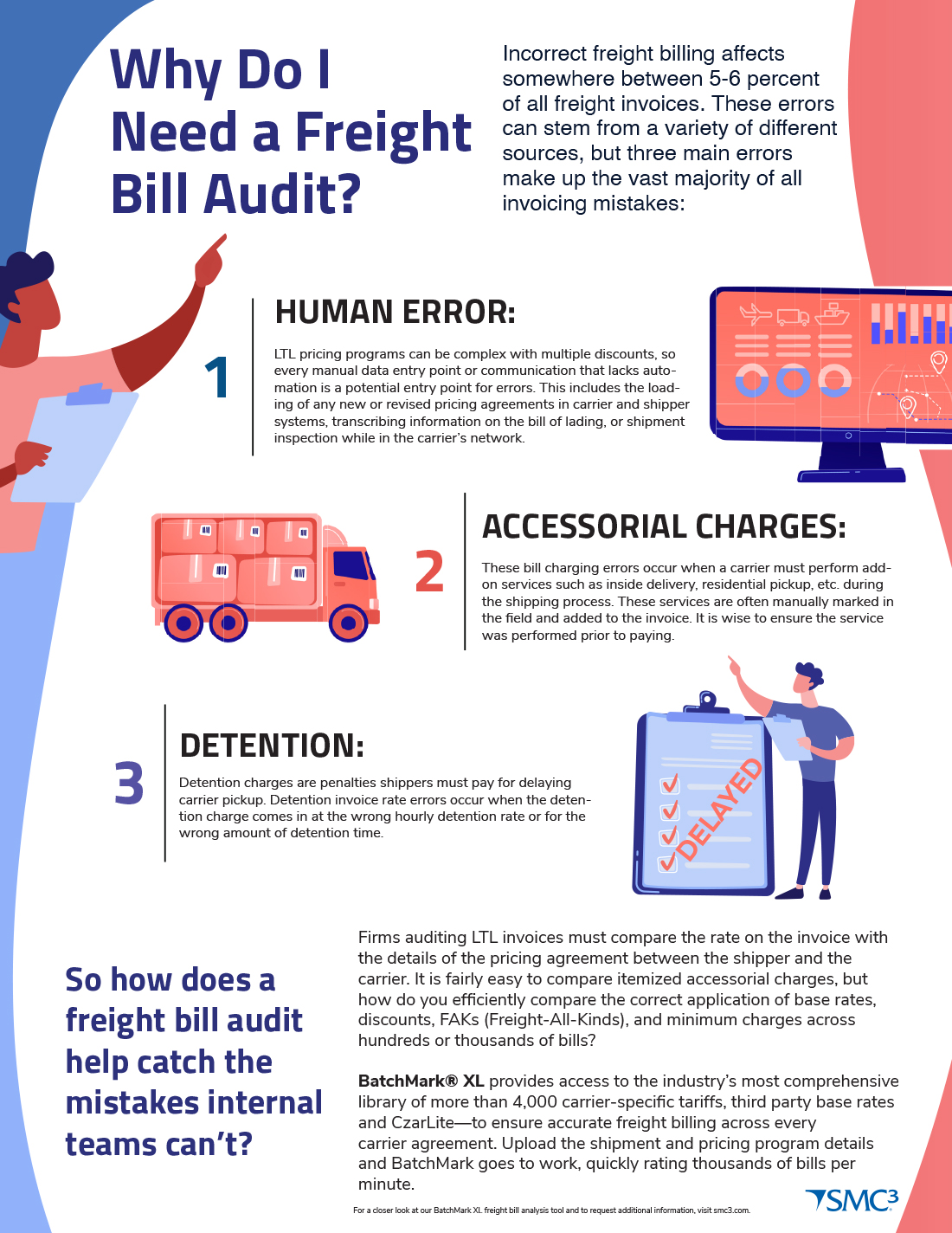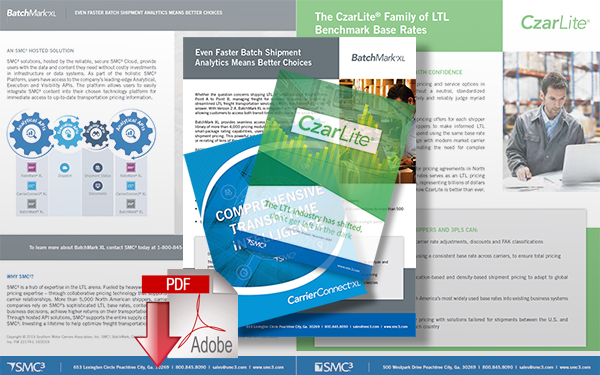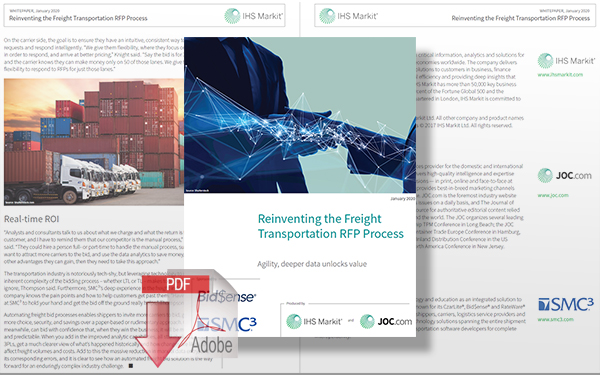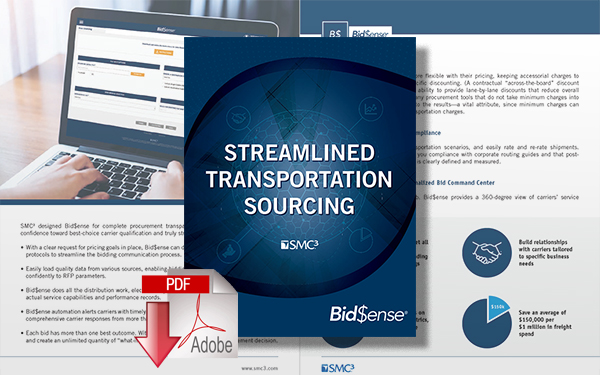What Is A Freight Bill Audit, and Why Do You Need One?

Incorrect freight billing affects somewhere between 5-6 percent of all freight invoices, and these errors can stem from a variety of different sources, but three main errors make up the vast majority of all invoicing mistakes.
Why Do I Need a Freight Bill Audit?
What is a freight bill audit, and why do I need one? In order to answer this question, let’s start by contextualizing the problem.
According to a recent report, incorrect freight billing affects somewhere between 5-6 percent of all freight invoices.[1]
These errors can stem from a variety of different sources, but three main errors make up the vast majority of all invoicing mistakes:
- Human Error: LTL pricing programs can be complex with multiple discounts, so every point of manual data entry or communication that lacks automation is a potential entry point for errors. This includes the loading of any new or revised pricing agreements in both the carrier and shipper systems, transcribing information to and from the bill of lading, or inspection of the shipment while in the carrier’s network.
- Accessorial Charges: These bill charging errors occur when a carrier must perform add-on services such as inside delivery, residential pickup, etc. during the shipping process. These services are often manually marked in the field and added to the invoice. It is wise to ensure the service was performed prior to paying.
- Detention: Detention charges are penalties shippers must pay for delaying carrier pickup. Detention invoice rate errors occur when the detention charge comes in at the wrong hourly detention rate or for the wrong amount of detention time.
Freight Billing Errors
Because billing errors generally go unnoticed, it’s virtually impossible to know how much money these errors could be costing your business each year.
However, freight bill audit data can begin to give you a better idea. One recent study suggests that adopting a freight auditing process to identify and remedy many of these errors can help businesses recover up to 5 percent of their freight costs.[2]
Without a proper audit process in place, these costly errors and overpays equate to unrealized revenue your company is literally giving away - for free.
So How Does A Freight Bill Audit Help Catch The Mistakes Internal Teams Can’t?
Most freight audit services are executed by a third-party provider. As part of the bill review process, the chosen provider deploys automated software that combs through each freight bill to closely examine and verify it for 100 percent accuracy.
When errors are found, remediation mechanisms are activated that enable both parties to rebill the LTL freight charges quickly and accurately.
Firms that audit LTL invoices must compare the rate on the invoice with the details of the pricing agreement between the shipper and the carrier.
It is fairly easy to compare the itemized accessorial charges, but how do you efficiently compare the correct application of base rates, discounts, FAKs (Freight-All-Kinds), and minimum charges across hundreds or thousands of bills? One answer is SMC³’s BatchMark XL.
[1] How to Tackle the Freight Invoice Management Obstacles
[2] Why Freight Audit Is Becoming Increasingly Important in the APAC Region
Solutions to Freight Billing
BatchMark® XL provides access to the industry’s most comprehensive library of more than 4,000 carrier-specific tariffs, 3rd party base rates and CzarLite® - to ensure accurate freight billing across every carrier agreement. Upload the shipment and pricing program details and BatchMark goes to work, quickly rating thousands of bills per minute.
In addition to uncovering potential freight bill invoice errors, BatchMark XL can assist with price negotiation and planning, enabling users to:
- Assess the impact of a carrier price increase or general rate increase on your business
- Illustrate the impact of changing from carrier base rates to a neutral base like CzarLite
- Calculate the impact of a new or revised FAK program
- Support bid analytics – compare multiple carrier price offers and transit standards
- Derive discount adjustments required to maintain a revenue neutral price program
For a closer look at our BatchMark XL freight bill analysis tool download our paper, including; BatchMark XL, CarrierConnect XL, and CzarLite.
Related Papers
Analyzing and Predicting Freight Transportation Costs
In these 3 resources, BatchMark XL, CarrierConnect XL, and CzarLite, we detail how to ensure accurate freight billing across every carrier agreement, uncover potential freight bill invoice errors, and assist with price negotiation and planning. Download Now!
Reinventing the Freight Transportation RFP Process
In this white paper, we describe how using a tech-enabled freight bid system allows for more freight providers to be considered, greatly improving choice and the ability to tailor your service around more than just price. Download Now!
Bid$ense: Streamlined Transportation Sourcing
This paper details how using Bid$ense leverages SMC³’s lifetime of transportation purchasing knowledge, allowing customers to incorporate pricing, claims ratios, on-time performance, and transit times into their LTL bidding analysis. Download Now!
More SMC³ Resources
Article Topics
SMC3 News & Resources
Mastering LTL Shipping: Strategies to Become the Carrier’s Top Choice Career Success in LTL: Insights from Industry Veterans Effective Strategies for Last Mile Returns in LTL Logistics SMC3 Mercury Gate Case Study - Improving Workflows and Enhancing Efficiency with LTL APIs SMC3: Is Technology a Competitive Advantage in the Modern Supply Chain Industry? Armada’s Prather examines the disconnect between the freight economy and the macro economy at SMC3 JumpStart 2024 SMC³’s Solution to the Logistics Industries Talent Problem More SMC3Latest in Transportation
Baltimore Opens 45-Foot Deep Channel Following Bridge Collapse El Paso Border Delays Cost Juarez $32 Million Per Day in Economic Losses Ranking the World’s 10 Biggest Supply Chains The Top 10 Risks Facing Supply Chain Professionals Walmart’s Latest Service: Ultra Late-Night Delivery City of Baltimore Files Lawsuit to Recoup Money for Collapsed Bridge The Era of Self-Driving Tractor-Trailers Set to Begin More Transportation

















